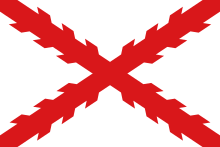Josep de Suelves i de Montagut
[3] In 1794 the title passed along the maternal line to Josep's great-grandfather, Joan Nepomucé de Suelves i Montserrat,[4] an anti-liberal Tarragona deputy to Cortes of Cádiz.
[6] His grandson, 8th marqués, Antoni de Suelves i d'Ustariz (Josep's paternal uncle), followed the family tradition forming part of Royal Council of the pretender Carlos VII[7] and since late 1860s participated in preparations to another insurgency.
[20] At the outbreak of the Spanish Civil War in 1936 he joined the insurgents and assumed command of the Carlist Requeté battalion of Tercio de San Ignacio from Gipuzkoa; killed in action in June 1937 in Sopuerta in Biscay.
Despite that his uncle was appointed royal commissioner for the native – though barely captured – provinces of Tarragona and Lerída,[25] Josep de Suelves remained on the Northern Front; he accompanied the pretender when setting a capital of the Carlist state in Estella.
[28] Pressed by the French authorities, the pretender boarded a ship in Boulogne and left for Britain; Suelves travelled with him, accompanying Carlos VII also in course of further voyages across the Atlantic to the United States and Mexico.
[29] In 1877 the claimant and his entourage returned to Europe and headed for the Balkans; in the Romanian Ploiești they met the Russian Tsar Alexander II and agreed taking part in the commencing Russo-Turkish War.
[32] It is not clear whether Suelves accompanied the claimant during the rest of his bon vivant period[33] and in successive journeys to Britain, again the United States, India, Africa and South America in the late 1870s and early 1880s,[34] though some sources indicate that his wedding of 1886 took place in Peru.
[40] Prior to the 1896 campaign Tamarit concluded that challenging candidates of two partidos turnistas in a single-mandate district was a lost cause; instead, he decided to run in the multi-mandate circunscripción of Tarragona.
[47] In 1918 he did not compete; Suelves/Montserrat[48] apparently intended to run for Senate, but eventually it was the former deputy from Gerona Dalmacio Iglesías who successfully represented provincial Carlism in the upper house.
[52] His electoral career was made possible by backstage political negotiations and by flexibility bordering opportunism, as Tamarit excelled in behind-the-curtain deals with whoever was prepared to agree them, regardless of ideological leanings.
[53] Since the three-mandate Tarragona district allowed much room for alliance negotiations, Suelves skillfully exploited the opportunity by maintaining good relations with governmental circles, partidos turnistas and parties on the borderlines of the system alike.
[63] As a politician perfectly well accommodated within the Restoration system and close collaborator of the non-belligerent Cerralbo,[64] he voiced against violence during the La Octubrada crisis,[65] though he probably formed part of a clandestine Tarragona junta collecting funds and arms for a would-be coup.
[69] In 1901–1903, when poor health threatened leadership of the national Carlist leader Matías Barrio y Mier, Carlos VII intended to relieve the latter of some duties by creating an auxiliary Junta Central; Tamarit was nominated its member representing Catalonia and Aragon before the body was dissolved shortly afterwards.
[79] During the Primo de Rivera dictatorship he did not hold any official positions, limiting himself to propaganda activities like gatherings of the ever-smaller group of combatants of the Third Carlist War.







